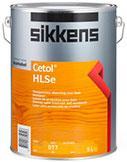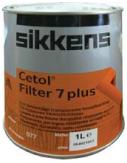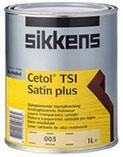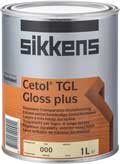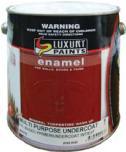01. FINISHING OF JOINERY
Table of contents
- DOES TIMBER HAVE TO BE FINISHED?
- WHY IS SEALING THE TOP AND BOTTOM SO IMPORTANT?
- DOES WOODWORKERS FULLY FINISH JOINERY?
- WHAT TRANSPARENT FINISHES ARE RECOMMENDED?
- DO I NEED AN EXPERIENCED TRADES PERSON TO PAINT JOINERY?
- WHAT IF I PAINT THE JOINERY WHITE OR WITH A COLOUR?
- WANT TO GO TO THE DARK SIDE?
- WHAT IF MY PAINTER WANTS TO USE DIFFERENT PRODUCTS?
- MY JOINERY WAS PRESEALED/PRIMED BY WOODWORKERS. WHAT FINISHES ARE COMPATIBLE?
- WILL WHITE PRIMER PREVENT TANNINS LEACHING FROM MY TIMBER?
- I’M RECOATING EXISTING TIMBERWORK - HOW DO I IDENTIFY THE EXISTING FINISH?
- WHY AVOID WATER BASED FINISHES?
- HOW SHOULD I PAINT A DOUBLE HUNG WINDOW?
- HOW DO I GET A SHOWROOM FINISH ON MY JOINERY?
- IS CEDAR MORE DIFFICULT TO FINISH THAN OTHER TIMBERS?
- THERE IS COLOUR VARIATION IN THE TIMBER. WHAT DO I DO?
- CAN I HAVE A DIFFERENT FINISH ON EACH SIDE OF JOINERY?
- MY JOINERY IS GLAZED. ARE THERE PRECAUTIONS I SHOULD TAKE?
- MY JOINERY GOT WET BEFORE BEING SEALED. WHAT DO I DO?
- HOW DO I AVOID PANELS OR BATS SPLITTING?
- WHAT ABOUT PROTRUDING NAILS AND NAIL HOLES?
- WHEN DO I FIT THE HARDWARE?
DOES TIMBER HAVE TO BE FINISHED?
YES - All timber joinery has to be finished to seal and protect it. By 'finishing' we mean the application of either an opaque or transparent finish applied to all 6 sides to protect it from the elements. Without a finish all timber will swell or crack and will discolour. No warranty applies to unfinished joinery. To preserve your warranty as well as your joinery, a full coat of sealer must be applied to dry timber joinery within 48 hours of delivery. Generally timber joinery will require of least 4 coats of finish, two coats of primer/sealer or undercoat and two top coats to give lustre and long-lasting protection. All joinery should be checked regularly but the life of the finish will depend on its exposure. Joinery fully exposed to weather and sunlight or joinery in coastal areas will need more frequent maintenance. Look for signs of dryness, peeling, surface split or discolouration.
WHY IS SEALING THE TOP AND BOTTOM SO IMPORTANT?
All six faces of the joinery are important and in some joinery units (bifolds, pivots, double-hungs) there are hard to reach places to finish. The top and bottom however, are crucial faces of the door - the stiles (or vertical edges) of the door were once part of a tree trunk and were designed to 'suck up' water. Water left sitting on the sill or on the top of the door is absorbed through the exposed end grain if not properly finished and this absorption leads to bowing, twisting and eventual rotting of the timbers.
DOES WOODWORKERS FULLY FINISH JOINERY?
Woodworkers does not completely finish joinery for a variety of reasons. However, we do offer a priming service on many of our products. It is our experience that trying to fully finish joinery before delivery or installation is fraught with potential problems. Sometimes joinery needs to be shaved and fitted during the installation process, then drilled and chiseled to fit the locking hardware. Once this work is completed the finishing coats can be contemplated. lf minor scratches, bumps and dents have occurred during the delivery or installation process they are relatively easy to rectify in a raw or pre-sealed item, but very difficult after the item has been finished.
The level of gloss or sheen usually needs to match surrounding work and it is better that architraves, joinery and surrounding timberwork is painted after installation to achieve a uniform result.
Our stock double hung range is usually available in a raw finish, clear pre-seal or white primed. Primed units manufactured in our overseas factory have multiple coats applied with sanding in between so all the hard work is done. Even those in a raw finish have had the spiral grooves sealed during assembly. For custom made joinery and locally manufactured stock items that are not glazed we can organize clear pre-sealing or white priming (generally the first coat only and you will still need to sand the joinery before applying subsequent coats). When we are informed whether the job is to be clear finished or painted a colour, but the client does not want to pay for us to undertake the priming work, we may document the job as “raw, sikkens acceptable” or “raw, white acceptable”. What these terms mean is that if we have pre-primed framing or joinery we may use it without charge at our discretion. You may receive only a portion of the order preprimed or none at all (depending on our stock position) but any primed components you do receive are a free bonus. Woodworkers has no obligation to supply primed items unless contracted to do so, but may endeavour to help clients where possible by providing preprimed componentry if available.
Certain products in our range (eg the vista and crimscreen doors) are only available with a seal coat applied. Don't worry if you're painting them. If you use a recommended oil based product (see below) it will be compatible with the seal coat.
Woodworkers also prime the top and bottom of bifold doors and pivot doors as a matter of course. These 2 edges of doors are often missed during finishing and maintenance and they are critical for moisture absorption into joinery which causes expansion and contraction.
WHAT TRANSPARENT FINISHES ARE RECOMMENDED?
Woodworkers recommend certain products in the SIKKENS range of finishes as being ideal for joinery. Please avoid water based acrylic finishes as they void your warranty. Sikkens is an oil based resin that has the advantages of
- Long life in exposed conditions & easy maintenance.
- Can be used internally & externally
- Easy to apply and easily re-applied over time.
- Nourishes the timber & prolongs its life.
- Easily removable from glass
- Lubricates items like double hungs and sliders thus enabling them to slide over each other more easily for smoother operation.
There are 2 products in the coating system – SIKKENS CETOL HLSe (sealer) and SIKKENS FILTER 7 PLUS (top coat) available in a range of tints as well as the pine clear 077 transparent finish.
DO I NEED AN EXPERIENCED TRADES PERSON TO PAINT JOINERY?
The answer depends on your own assessment of your skills to DIY, the project and the level of perfection you want to achieve. Skilled painters are hard to find and many will baulk at using oil-based paints because of the repetitive visits required to apply each coat. Nonetheless, a good painter will either make or break the final appearance of your joinery.
Apply caution, and clarify the qualifications when using internet-based labour suppliers such as Airtasker, Taskrabbit, HiPages, Service Seeking etc as you have no idea of the competence of the people that can answer your enquiry, and we have witnessed some horrific outcomes where good joinery has been totally ruined by amateur painters targeting a budget.
What the client wanted:
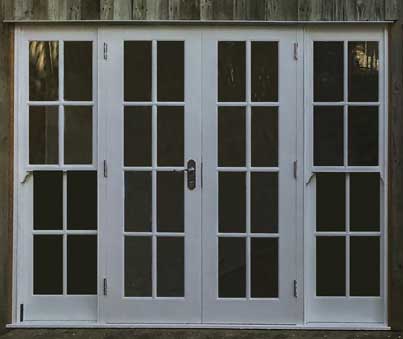
What the client got:
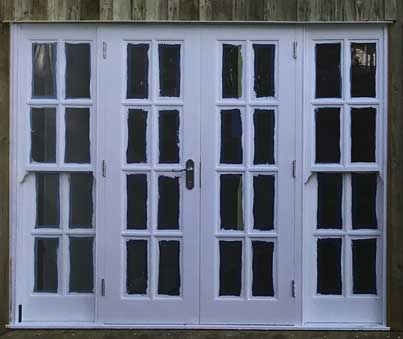
WHAT IF I PAINT THE JOINERY WHITE OR WITH A COLOUR?
We recommend only an oil based enamel finish for joinery, NOT acrylic coatings (water based). There is a great deal of difference in oil based coatings available and not all products will give you the finish that you want. Most are formulated for weatherboards and external timber and contain very high oil levels which dry slowly and are very difficult to sand. Because joinery requires numerous coats with sanding in between, the primer/sealer needs to be a fast drying oil paint able to sand to a fine powder. Top coats of enamel should only be applied when the base coats have been sanded smooth as you should not sand top coats for a professional finish. Avoid all dark colours for external joinery as it will attract and retain heat and can cause the joinery to warp or shrink. Woodworkers stocks the products recommended later in this flyer as you may find them difficult to purchase through normal paint outlets. Woodworkers does not recommend any particular brand of top coat enamel as this is an aesthetic choice based on the level of sheen required and the colour chosen.
WANT TO GO TO THE DARK SIDE?
Clients are often tempted to add a dash of drama to their front door in the form of dark paint. You might think a dark colour will contrast with a white exterior to give a sophisticated look. Unfortunately dark paint and exterior doors don’t always lead to a happy union. If you’ve ever been out in the sun dressed in dark colours and felt uncomfortably hot, it is because dark-coloured clothing naturally absorbs light, while light colours reflect it. When it comes to your home’s exterior doors, the situation is no different. Because black paint absorbs more UV rays than lighter colours, a black door will become hotter than it should. Interior doors & furniture do not have to withstand the sun, but an exterior door faces the elements directly. It can be 20 degrees on the inside of the door due to air conditioning being turned on, and 35+ degrees outside in summer. A dark colour exterior door that absorbs heat each day will swell and shrink over and over until the timber cannot take it anymore. What happens then is that some doors may split, crack or warp and may no longer fit properly in the frame. The door frame may even warp in reaction to the swelling door. These negative side effects are why painting your door can void your warranty. A timber door that would last years if painted white or cream may deteriorate quickly if the wrong colour or stain is used with the wrong type of paint. However, if you are determined to use dark colours there may be a glimmer of light at the end of the tunnel. All paints have something called a Light Reflectance Value, or LRV. Look for paint with a LRV of 50 percent or higher. The higher the paint is on the LRV index, the more light it will reflect, and the less likely it is to cause a timber door to crack or warp. There are some newer paint products from manufacturers such as RESENE which have cool colour technology paints that perform better with the LRVs than traditional paints. The Woodworkers Company warranty states that only external joinery with an LVR greater than 50 are covered by the warranty. A dark coloured exterior door might sound great in theory, but the reality is you have to do the research to ensure you will qualify for a warranty with your choice of colour and brand, and ensure the manufacturer’s recommendations are followed to the letter by your painter.
WHAT IF MY PAINTER WANTS TO USE DIFFERENT PRODUCTS?
Some painters prefer quick application coatings that give them a very profitable turn around but can be disastrous for the joinery and its owner. Generally speaking, if the joinery is completely internal you can use any finish, but for external items the following is a list of products you should avoid
- Polyurethane coatings, estapols and lacquers - All such finishes are too inflexible and restrain natural timber movement. They therefore crack quickly and because they retain and concentrate heat, can cause severe warping or splitting in the joinery. They also break down quickly in ultraviolet light. These finishes void your joinery warranty if used externally.
- Acrylic coatings - As explained above acrylic finishes suffocate timber. Coatings tend to 'stick' and restrict movement where, for example, sashes have to slide across each other in windows and doors. They are generally complicated to re-apply over time requiring etching and other surface keying to permit subsequent coats to bond. These finishes void your joinery warranty if used externally.
- Varnishes and Natural oil finishes - Marine varnishes do not have a long life & most modern varieties have similar disadvantages to lacquers. Natural oil finishes are good for the timber but tend to be absorbed over a fairly short time so that regular recoating is required.
- Water repellent preservatives - Contain repellent waxes, resins and usually fungicide to provide a temporary water barrier which breaks down progressively due to atmospheric oxidization. Can cause compatibility and bonding problems with subsequent finishes.
MY JOINERY WAS PRESEALED/PRIMED BY WOODWORKERS. WHAT FINISHES ARE COMPATIBLE?
Woodworkers use oil based clear seal and white primers. Our transparent finishes will be compatible with Sikkens top coats and white primed products will require oil enamel top coats. You cannot mix paint systems as chemical reactions can occur. Water based top coats will not bond to oil primers. It is essential that the integrity of a paint system is preserved if it is to have its optimum service life.
WILL WHITE PRIMER PREVENT TANNINS LEACHING FROM MY TIMBER?
The white primer used by Woodworkers is a stabilizer and filler primer, designed to fill imperfections in the grain, and allow for sanding to a smoother finish. The purpose of the primer coat is to adhere to surfaces and form a binding layer that is better prepared to receive subsequent paint coats. However, the primer coat is not a waterproof sealer, and if the timber gets wet prior to the top coats being applied, the tannins can run through the primer coat. This is especially applicable to high tannin releasing timbers such as Kwila (Used on joinery sills, balustrading etc.). If you don’t intend to apply the top coats prior to the timber getting wet, we would recommend the use of a stain blocker primer. (This product is not part of Woodworkers range).
I’M RECOATING EXISTING TIMBERWORK - HOW DO I IDENTIFY THE EXISTING FINISH?
Modern external finishes are likely to be either acrylic or oil based. If you saturate a rag with methylated spirits and rub the finish, you will see a softening of the finish and some rub off on the rag if the finish is water based acrylic. You will see no effect if the finish was oil based.

WHY AVOID WATER BASED FINISHES?
Woodworkers do not recommend or warranty external joinery painted with most acrylic (water based) paints because they have the effect of wrapping the timber in plastic so that the wood can't breathe. Just as food wrapped in a plastic bag will rot over time, non-porous acrylic paints hasten the demise of timber. Importantly, when the seal is broken in an acrylic coating water can be drawn into the moisture hungry timber and become trapped in the plastic encasing causing rot and fungal growth to occur in the waterlogged woodgrain. This is particularly likely with external fully exposed joinery such as gates. Acrylic paints also tend to cling to each other causing sliding sashes to stick. Coatings need to be microporous, allowing the timber to breathe and move and should contain organic oils to nourish the wood the way it was treated within its tree. For this reason Woodworkers recommends finishes that are oil based, which are flexible to allow movement and are proven to be remarkably durable.
HOW SHOULD I PAINT A DOUBLE HUNG WINDOW?
Woodworkers recommends that the sashes be removed to finish a double hung window and has compiled a video to show how to remove and re-tension spiral balances. If this is not done it is virtually impossible to avoid getting paint on the spiral balances which looks unsightly. It is important that acrylic paints are not used for sliding sashes as they cause sashes to stick rather than slide smoothly.
HOW DO I GET A SHOWROOM FINISH ON MY JOINERY?
Apply the first coat of SIKKENS HLSe within 48 hours over clean raw timber. After applying the initial coat, when dry, lightly sand along the grain of the timber using a fine (preferably sponge backed) abrasive pad, 180 grit sandpaper or fine stainless steel wool. Do not fill nail holes etc until after the first coat is applied as unsightly smear marks will be trapped under the finish and will not be removed easily. Stop holes after the first coat of sealer with an oil based wood fill putty that is darker than the timber (Walnut generally has the colour of a timber knot, whereas commercially available Cedar putties are generally lighter than the timber and do not blend in successfully). Repeat the sealing and sanding process until a smooth even finish is achieved. It is important that all smoothing and preparation be done at the priming/sealing stage as you should not need to sand the top coats. SIKKENS FILTER 7 PLUS (with UV filters for added protection) is recommended for the top coats as it builds quickly to a rich satin finish. The process of finishing the frame timbers is the same, but be aware that the outside of the frame including the underside of the sill needs to be fully sealed before installation.
IS CEDAR MORE DIFFICULT TO FINISH THAN OTHER TIMBERS?
YES - Surian Cedar is an excellent timber for joinery because of its durability (class 2), stability, natural termite and borer resistance and its superb colour and grain. It is one of the world's most beautiful timbers but it requires special attention to achieve a quality result. Surian is a short grained timber prone to small amounts of tear out during machining and its fibres can stand up when wetted by the primer coats resulting in 'furriness'. This is normal and not a defect. Once the primer is fully dry it is simple to lightly sand off these fibres and recoat with the primer to achieve a smooth base for further coats. It is essential that any furriness is removed during the undercoating stage, making sanding unnecessary between top coats. lf you or your painter follow the recommended procedures and products on this FAQ you will be able to get a showroom finish to your joinery.
THERE IS COLOUR VARIATION IN THE TIMBER. WHAT DO I DO?
Timber is a natural product; that is part of its beauty, so colour variation is to be expected. We do not colour match timber during fabrication as the waste from such practices would be environmentally irresponsible. See our FAQ #4 on timber and glass. Our recommended transparent finish, Sikkens, comes in a range of tints and a skillful painter should be able to stain out any major colour variations in your joinery if you are seeking greater conformity than is natural with raw timber.
CAN I HAVE A DIFFERENT FINISH ON EACH SIDE OF JOINERY?
Generally door manufacturers will not warranty a product that has a different finish on each side as finishes can 'unbalance' the door and cause bowing or twist. This could occur if, for example, you used a polyurethane finish internally and an oil finish externally. However, if you used an oil based transparent finish internally and an opaque oil finish externally the problem should not occur. Houses built early last century, or earlier, successfully used transparent varnishes internally and oil finishes externally e.g. Newstead House, Brisbane.
MY JOINERY IS GLAZED. ARE THERE PRECAUTIONS I SHOULD TAKE?
For glazed items it is recommended that you run the primer coat 1 mm onto the glass to achieve a good seal between the glass and the timber. It is also important to remember to be very careful when sanding near the glass as it is easily scratched in the process (particularly items with toughened glass which is VERY prone to scratching). It is important that you check the item upon delivery as any claims of scratched glass are difficult to resolve once the item has been on site for any length of time. For more information on glass, see our FAQ #4 on timber and glass.
MY JOINERY GOT WET BEFORE BEING SEALED. WHAT DO I DO?
lf your joinery gets wet before being sealed it can result in water marks. As soon as possible after the joinery has been exposed to rain or dampness it should be rubbed over entirely with a damp cloth to even out the 'wetness' and then be allowed to dry completely. lf a 'high tide' mark is still in evidence it can generally be removed by sanding.
HOW DO I AVOID PANELS OR BATS SPLITTING?
Woodworkers do not recommend large bats or fielded (raised) panels for external use. Where they are used they need to have extra care in sealing and maintenance especially for exposed situations. Most door designs use plywood rather than solid timber for panels because the inherent strength of plywood eliminates the chance of splitting. Where solid timber is used either for bats (e.g. Cricket bat doors) or panels (e.g. 8 panel door), special care needs to be taken to reduce the chance of splitting. Doors are constructed using the floating panel method which allows panels to move slightly within the door as they expand and contract due to moisture variations. If a finish is used which effectively cements the panel in place, pressures can build up that will crack the solid timber. This is why flexible finishes are preferable to hard urethanes or lacquers. Where you have doubts about the ability of the panels to move, it is best to cut a fine line around the junction between the door's structure and the panels with a stanley knife to ensure they can move freely. For timber bats there is no substitute for ensuring the bats are very well coated with 4 or 5 coats of finish to shield the timber against moisture intrusion even after several years service.
WHAT ABOUT PROTRUDING NAILS AND NAIL HOLES?
On some frames nails may deliberately be left protruding where there is a likelihood that the timber bead may need to be removed for painting or installation. This is traditional joinery practice and not an oversight or error. Importantly Woodworkers does not stop up nail holes as this needs to be done AFTER the first seal coat is done. lf these are puttied beforehand it usually leads to unsightly smear marks under the prime coat that cannot easily be removed.
WHEN DO I FIT THE HARDWARE?
lf your joinery has been supplied pre-hung in a frame then the operating hardware (hinges, spiral balances, friction stays etc) are already attached. Your choice of locks and handles will need to be fitted after the item has been installed although Woodworkers will prepare mortice holes for locks if contracted to do so. It is best to do the drilling/chiseling required for these items, re-seal the exposed timber, finish the door and then fit the hardware.
lf your builder is fitting weatherseals to your joinery they should be fitted after the door and any grooves are sealed.
All prices in our product catalogue.
SIKKENS TRANSPARENT FINISHING SYSTEMSWoodworker's experience with the wide range of coating systems has led us to strongly recommend the SIKKENS range of timber finishing products for our joinery. We believe the range provides the best nourishment for timber, very good durability and minimises hindrance to the smooth operation of joinery.
Note: all exterior finishes must have some pigmentation to provide UV resistance. Sikkens products come in a range of pigments but Woodworkers only stocks the popular colours listed at left. Should a gloss finish be required, use TGL-plus, but remember a gloss finish externally will dull over time.
Preparation and ApplicationEnsure surfaces are clean and dry. Sand along grain using a fine abrasive paper. Products are best applied by a long haired brush. Ensure end grain is thoroughly coated (especially top and bottom of doors and windows). A light sand is likely to be required after the application of HLSe particularly on Red Cedar due to the grain raising which is characteristic of the species. Re-apply HLSe to any area where sanding has revealed raw timber before applying topcoats. Solvent based Gupa wood filler can be used as filler/stopper for both interior and exterior use. Nail, holes etc. should be filled with Gupa after the application of the first sealer coat. It can be overcoated with transparent wood finishes. For further information refer to Sikkens Technical Data Sheets.  |
|||||||||||||||
 My Account
My Account My Wishlist
My Wishlist My Enquiries
My Enquiries